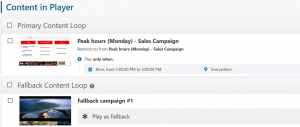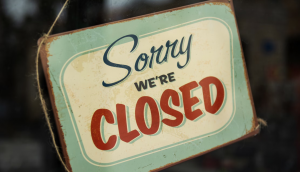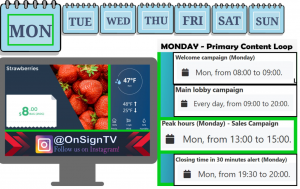When handling visual campaigns, OnSign TV users have two playback loops at their disposal. The first is the primary loop where your scheduled content is displayed. This is a sequence of all the content you regularly publish and want the viewer to see, including your menus, ads, announcements, etc. In the case of a gap in this primary loop and there’s no campaign to display, the fallback loop kicks in.
The reasons for gaps in your content vary, but it is quite likely you’ll eventually stumble across one. Maybe the schedule was miscalculated or a campaign got accidentally deleted and can no longer be displayed. OnSign TV will normally warn you if you’re about to delete a file or campaign that is published on players, but mistakes can still happen, especially with mass deletion. In these instances, the fallback loop ensures the viewer doesn’t notice this failure, nor experiences any disturbances because of it. The fallback loop keeps the content flowing at all times. In this article, we’ll cover the benefits of using the fallback loop, and when you’ll need it the most. When you’re ready to create one, take a look at our in-depth step-by-step tutorial!
Fill in a gap in the schedule
If you’re managing a variety of content or switching up campaigns daily, it can happen at times that you miscalculate and end up with an hour or two where there’s no content scheduled. Of course, it’s always good to account for each and every hour, but the fallback loop ensures the customer doesn’t realize there’s a gap in the schedule.
Lack of content or schedule gaps can happen during maintenance or other changes in the business. Maybe a piece of content isn’t ready in time, or the information in your current content has become obsolete and you need to pause it. The fallback loop will keep those gaps filled in until you can create the appropriate content.
Compensate for playback failure
At times, certain content pieces may fail to play. This can be for a variety of reasons, with one of the most common being accidental deletion, especially in complex structures with a larger number of employees. It can happen that you or one of the newer employees wants to tidy up the workspace, but they end up deleting campaigns which are in use. In this case, a gap is created in the primary loop, and the fallback loop comes in to bridge that gap.
Don’t worry, there are other fail-safes on the platform to help you out in this situation. The Health Check option is a great way to check if there are any issues with campaigns, playback, or storage space. Keep in mind that your fallback loop will kick in only if there’s an entire campaign missing from the primary loop, so it won’t help with missing files. For that, a regular glance at the Health Check option will tell you everything you need to know.
Furthermore, you may also want to look into permissions and set who can edit what, and maybe even restrict access to specific files. For example, if you build a fallback campaign, it is wise to place those files in a folder and restrict anyone from accidentally deleting it.
Display content outside of work hours
Displaying content after closing time is by no means going to make a massive impact on your business. After all, a closed store is not that exciting nor can the signage really engage a lot of people. But still, some simple content at these times can be memorable for passersby. There’s something about that image that stays in your memory: a closed store with something going on inside.
You may want to design some custom content for those times, maybe an announcement on when the store is opening, or an exciting upcoming sale. Setting up a fallback campaign will also do the trick. At the very least, it will fill in this time until you build something specific to display outside of work hours.
What content should you display?
You can’t predict when there will be a gap in your schedule. If you could, then you’d simply tailor content for that time. So the fallback loop should have content equally ideal for 7AM as for 5PM, since you don’t know when it will be needed.
The ideal content for your fallback loop is something general and unspecific. Your business information is a great start. You can feature the latest offers and discounts, but if you do, you need to ensure this information is accurate at all times. If you want a fallback loop that you can build and just forget about, highlight only your brand and possibly your main offers. You can also share some secondary content such as entertainment, jokes, inspirational quotes, fun facts, or even display photos of your employees for a more personal touch. OnSign TV has a variety of apps to cover all of these bases, so you can set up a fallback loop in a jiffy!
Don’t forget that a quality primary loop is even more important! Check out our guidelines on building the perfect primary loop based on time of day, as well as location of your displays.
Alongside a powerful primary loop, a quality fallback loop is an excellent asset to have to bridge any gaps which may appear. Once you set up a general fallback loop appropriate for all times in the day, you can forget about it! Ideally, you won’t need to rely on it, but mistakes happen from time to time. And if they do, it’s not the end of the world. But if your digital signage software can make it appear for your viewers to never even notice those mistakes, why not take advantage of it?








